Caledonian Sleeper Seat Review: What Is It Really Like?
This post may contain affiliate / compensated links. As an Amazon Associate, I also earn from qualifying purchases at no extra cost to you. For full information, please see my disclaimer here. Thank you!
The Caledonian Sleeper is one of the most famous railway journeys in the world. Running between London and Scotland overnight, it promotes a golden age of train travel but it comes with a hefty price tag.
There is one budget-friendly way to ride this iconic train and that is by choosing a seat rather than a bed.
In this Caledonian Sleeper seat review, I share what the seat is really like, how it compares to a bed and why I don’t recommend this route if you only want to go from London to Edinburgh.
I travelled from London to Inverness in the Caledonian Sleeper Seated Coach. Read on to find out how I got on.
What is the Caledonian Sleeper?
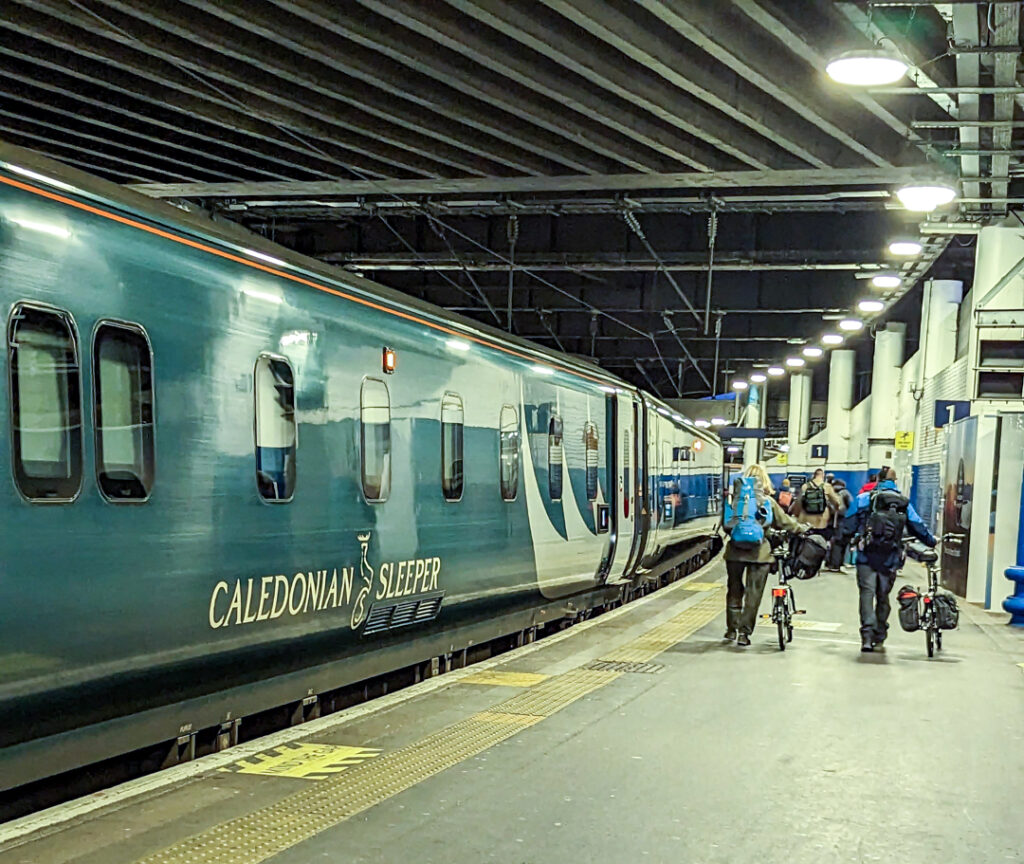
The Caledonian Sleeper is one of two sleeper trains that operate in the UK (the other is the Night Riviera from London to Penzance).
Commencing in 1996, it’s renowned for being a high-end, luxury train travel experience. There are two routes – the Highlander and the Lowlander serving different parts of Scotland. It runs every day of the week except Saturday.
For more information on routes, timetables and prices, read my detailed review of the Caledonian Sleeper Classic Room.
Accommodation options on the Caledonian Sleeper
The Caledonian Sleeper train has a choice of accommodation types to suit your budget and preferences. I’m not going to go into too much detail as I’ve covered them quite extensively in my Classic Room review.
If you’re short on time, here’s a quick overview:
- Caledonian Double En-Suite
- Club Room En-Suite
- Classic Room
- Seated Coach
Caledonian Sleeper reclining seat
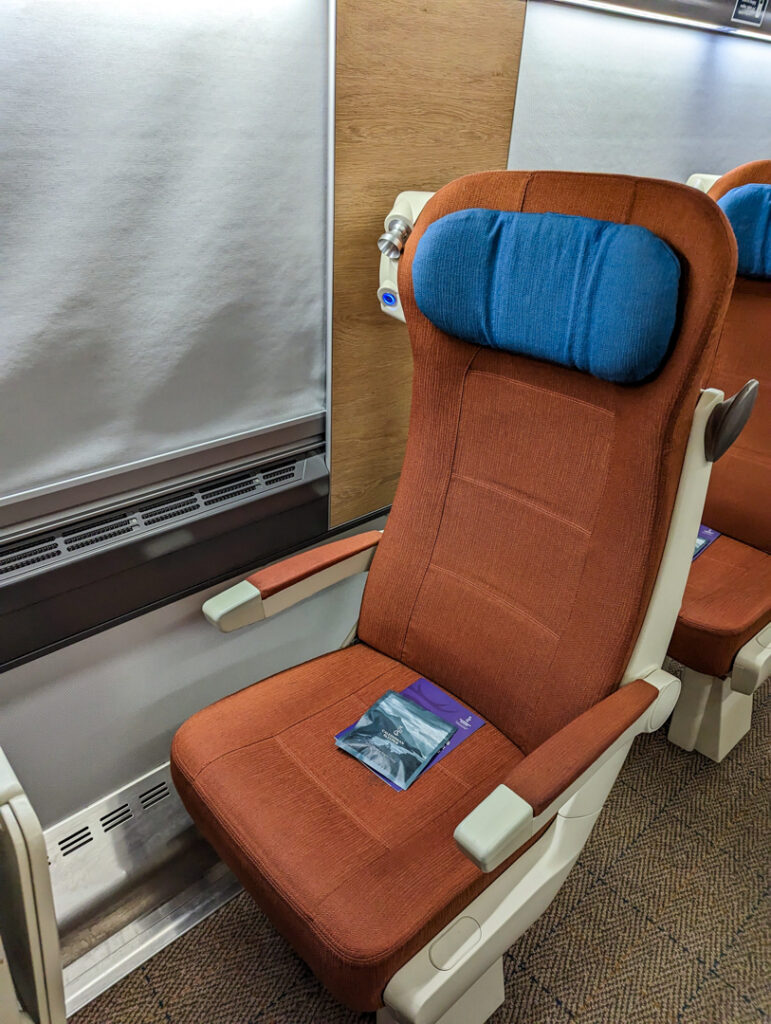

Since this is a Caledonian Sleeper seat review, let’s look at what you get if you choose the Seated Coach option:
- Adjustable headrest
- Adjustable footrest
- Tray table
- Individual reading light
- USB charging port and plug socket
- Wi-Fi
- Secure overhead storage
- Call button for at-seat service
- Food and drink menu
- Complimentary sleep kit
- Luggage storage area
- 10 degrees of recline
The Caledonian Sleeper seats are comfortable, clean and well-maintained. You also have plenty of space and legroom.
You can slide the seat forward to get 10 degrees of recline without disturbing the passenger behind (unlike on a plane!).
The USB charging port and plug socket are on the back of the seat in front of you. The reading lamp is beside you plus the secure locker and call button are above your head.
As for the table, it’s wide enough to hold all your snacks and entertainment and I found that I didn’t have to fold it up to get out.
The Caledonian Sleeper seat plan in a carriage is two on one side of the gangway and one on the other.
Your seat is reserved at the time of booking so you can’t just sit anywhere. If you’re travelling as a group, you’ll want to make one booking altogether if you want the best chance of sitting next to each other.
If you’re travelling solo, the single seat is ideal. This should be labelled as A – or at least mine was!
Call the reservations team in advance to secure the seat you want.
In the worst-case scenario, you can always ask nicely to swap seats if the other people in your row happen to know each other.
Chances are they will be happy to because who would want to sleep next to a stranger given the choice, right?!
Editor’s tip: If you see the words ‘Comfort Seat’ knocking around the internet, that’s what Seated Coach was referred to up until recently. I’m not sure why they changed it but it’s probably to do with the new operator – just in case you get confused!
Reclining seat versus a Classic Room
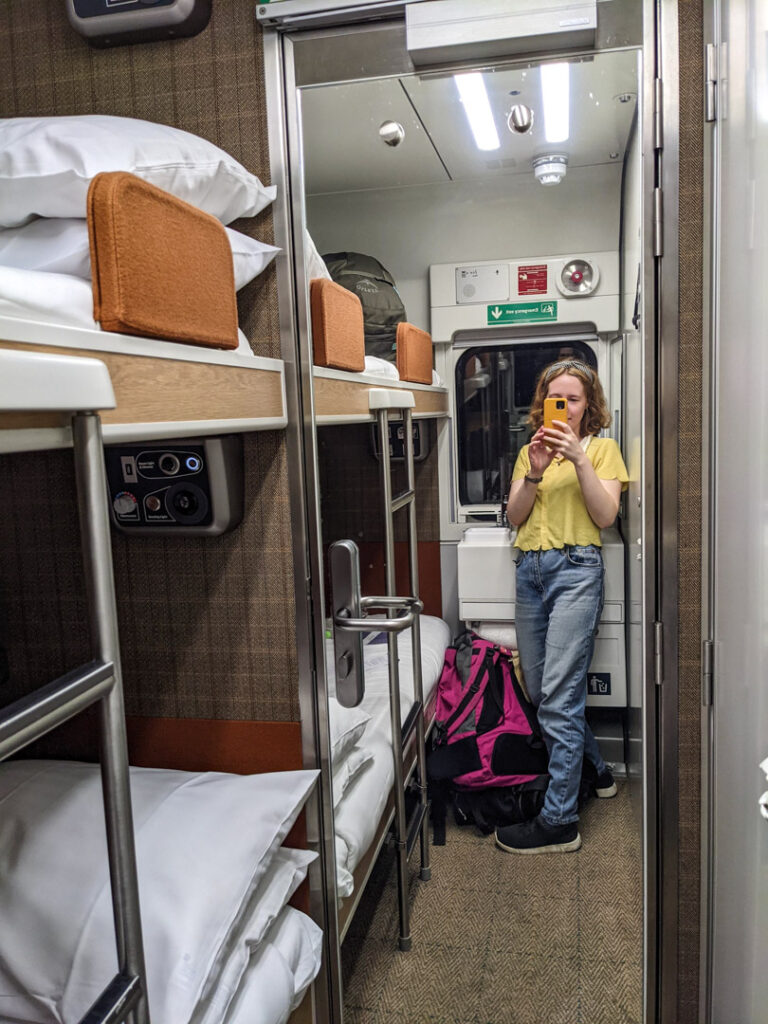

The Classic Room is the accommodation type above Seated Coach. In other words, it’s a bed rather than a seat.
So, you might be wondering what’s the difference and is it worth upgrading to sleeping horizontally rather than sitting down? Don’t worry, I’ve got you covered!
Here’s what you get in a Classic Room:
- Twin bunk beds with Glencraft mattresses
- Breakfast available for purchase
- In-room washbasin
- Wi-Fi
- Charging points
- Room Service
- Keycard entry
- Temperature control
- Dimmable lights
Other than a single bunk bed, the main difference is that you get a compartment and access to the Club car.
The price is significantly higher though, starting from £190 for solo travellers and £240 if you’re sharing. In comparison, the seat starts from £50.
If you’re travelling solo and book a Classic Room for yourself, you won’t have to share it with a stranger, but since it’s a measly £50 less than two-person occupancy, it’s not the most economical choice.
The first time I rode the Caledonian Sleeper, I was travelling with my partner so it made sense to get the room. The second time, I was alone so it was much more budget-friendly to book the seat instead.
Editor’s tip: Check that your power socket is working. The woman in front of me found that hers wasn’t. Luckily, I always carry a world travel adapter, and she was able to slot her USB cable into it around the back of her chair.
How much does a reclining seat cost?
The Seated Coach starts from £50 per single ticket from London to Edinburgh or Glasgow or from £55 from London to north of Edinburgh or Glasgow. Prices rarely change for seats unless there are only a few tickets left.
You can book your return journey at the same time as your outbound journey, but they will be listed as two singles. Some Railcards can also be applied to lower the cost.
To get the best rate possible for your seat, I recommend booking in advance as much as possible. You can book your ticket up to 12 months before you travel!
Caledonian Sleeper seat versus other train options

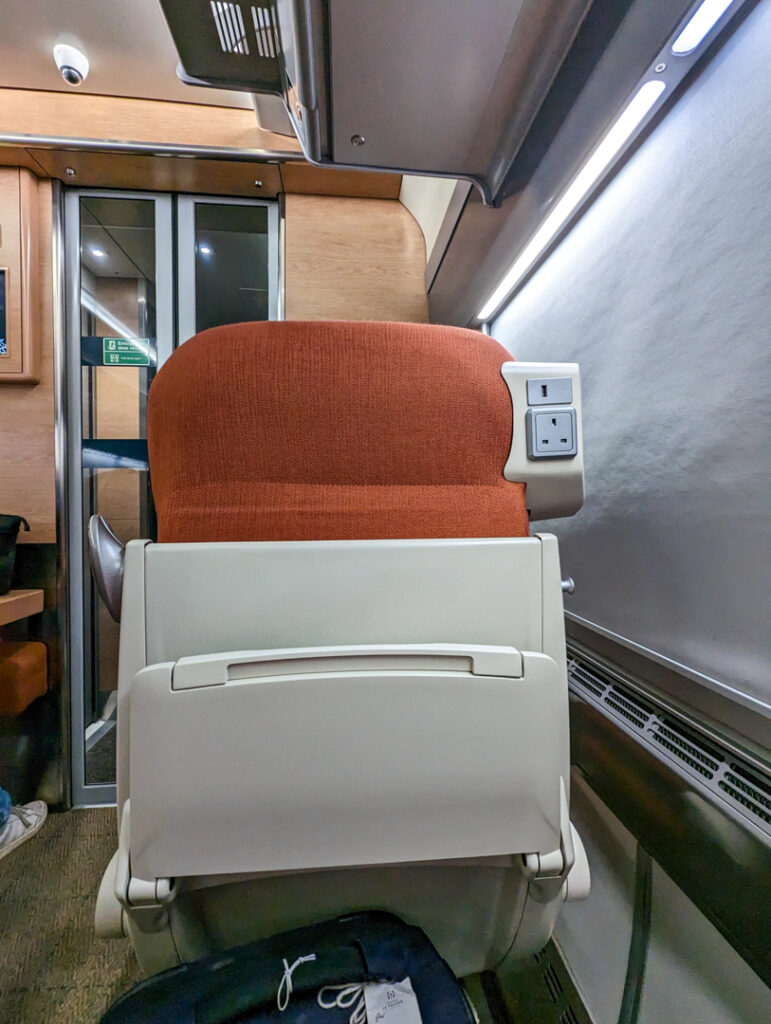
The seat is more competitively priced than the beds, but how does it match up to other operators?
First of all, you should bear in mind that the Caledonian Sleeper is more about the experience which is why it takes significantly longer than the other trains. If you’re travelling to Edinburgh, at least (more on that later!).
Read more: 13 Awesome Day Trips From Edinburgh By Train Or Bus
The price difference
So, let’s look at the cost. I’m basing the below on the price of single tickets as that’s how the Caledonian Sleeper is costed (e.g. a return would be two singles).
You might also want to take the sleeper train up and a different train down – like I did!
Price based on a one-way train from London to Edinburgh:
- LNER Azuma – from £32.20 (about 12 weeks in advance)
- Avanti West Coast – from £35 (about 12 weeks in advance)
- Lumo – from £19.90 (12 weeks in advance)
- Caledonian Sleeper – from £50 (12 months in advance)
If I’m being completely honest, these prices are a little bit wishful thinking. On average, you’ll most likely pay around £50 for a single ticket on other train operators too.
Price of a train from London to Inverness:
This is where it gets a bit complicated, as there are only two trains that go directly from London to Inverness. These are:
- LNER Azuma – from £58 (cheapest I could find)
- Caledonian Sleeper – from £55 (12 months in advance)
A more realistic price is between £55-80 for a single ticket. For other train operators, you will need to change at Edinburgh or Perth and continue on a different train.
The best possible way to keep costs down is to use an app like Trainline or Trainpal as they’re great at finding Splitsave tickets. Your route may be a bit long-winded it will be cheaper!
I paid:
- £55 for the Caledonian Sleeper from London to Inverness
- £56.90 for a single ticket from Inverness to London (I have a 26-30 railcard)
I could have probably found a better deal for the return but I was bound by time constraints.
How long it takes
Based on a journey from London to Edinburgh:
- LNER Azuma – approx 4 hours 20 minutes
- Avanti West Coast – approx 4 hours 42 minutes
- Lumo – approx 4 hours 32 minutes
- Caledonian Sleeper – approx 7 hours 30 minutes (remember, you’re travelling through the night)
Based on a journey from London to Inverness:
- LNER Azuma – about 8 hours
- Caledonian Sleeper – about 11 hours
Convenience
Based on a route from London to Edinburgh:
I think it’s more convenient to pick LNER Azuma over the Caledonian Sleeper if you’re just travelling to Edinburgh. It’s quicker, cheaper and you don’t arrive in the middle of the night.
Based on a route from London to Inverness:
If your time is limited and you’re on more of a budget, the Caledonian Sleeper Coach Seat is more value for money.
Your travel and accommodation are all in one plus you have the daytime to relax or enjoy your trip.
Editor’s tip: Read my detailed comparison of the best trains from London to Edinburgh.
Caledonian Sleeper food menu


You don’t have access to the Club Car dining carriage if you’re travelling in a seat. However, you can still order food from the menu and have it delivered. I did this for breakfast.
It wasn’t clear when exactly breakfast service started, but I recommend ordering it between 6-7 am. That may seem early but you’ll want to put your order in more the staff are busy in the Club Car and have enough time to eat it before arriving at your stop.
This is based on travelling from London to Inverness or Fort William. If your arrival time is before 8 am, you should order yours earlier.
So, what’s on the Caledonian Sleeper breakfast menu?
- Scottish Porridge Pot – £4.50
- Bacon Roll – £5.25
- Lorne Sausage Roll – £5.25
- Vegan Sausage in Morning Roll with Sweet Pickle (VE) – £5.15
- Granola Yoghurt (V) – £4.50
I had a porridge pot and a coffee which was pretty filling – just as well considering the price!
If you’re departing from London, you’ll have a few hours to order dinner service. This changes seasonally, but if you’re curious about what that’s like, read my Caledonian Sleeper Classic Room review where I tried out the Club Car.
There’s also a modest selection of soft and alcoholic drinks and snacks but between you and me, I recommend bringing your own. There are lots of shops around Euston Station to help you stock up!
Caledonian Sleeper reclining seat review: My experience


So, what’s it like to ride the Caledonian Sleeper seat? Let’s get to it.
Boarding
Okay, first of all, the Caledonian Sleeper is long as it splits off in different directions throughout the journey.
I had to walk almost to the end of the train to find my seat which meant I got some exercise in before sitting down for the night.
I got to my carriage first. There weren’t as many seats as a regular train which made it nice and cosy.
There were thick blinds pulled down over the window – I made a mental note to push it up at some point during the journey because who doesn’t want to see the dawn light over the Scottish Highlands?
The only drag about the blinds is that you share a window with the person either in front or behind you so you have to hope they’re on the same wavelength as you. Lucky for me, they were!
I got myself settled and soon more people started filling up the carriage.
The night
I spent the first couple of hours watching a film and eating snacks. The carriage was fairly quiet and the lights were on but dimmed.
At about midnight, most people were in sleep mode. I thought I should attempt to do the same. I didn’t sleep. I may have dozed a little bit, but no deep slumber for me.
This isn’t particularly new to me. I don’t sleep on planes either. It’s the combination of sitting upright and the noise.
In the Caledonian Sleeper Seated Coach, they also don’t turn the lights off. If you need it to be pitch black, bring a thick sleeping mask!
Oh and bring a blanket as it’s a little cool.
At about 4.30 am, I decided to give up on sleeping and look out the window instead. THAT’S what I was here for, after all.
Watching the shadows of the Scottish countryside emerge in the dawn was a real treat. It was early April at the time and a rolling flog hung low over the fields.
The sun soon made short work of it and the golden light bathed the landscape. I saw rivers, waterfalls, glens, hills, lochs, farmland and plenty of wildlife as the train sped up the Highland Main Line to Inverness. It has since become one of my favourite train journeys in Scotland.
Breakfast
At 7 am, I decided to get some breakfast and a much-needed coffee.I was just in the nick of time as it was almost at the end of service and there wasn’t much left. I felt they could have done a better job of letting us know beforehand.
Still, I was able to scrounge a porridge pot, coffee and some water. There’s nowhere to fill up your water bottle on-board so make sure you bring enough with you otherwise, you’ll have to buy some like I did.
My breakfast came with a lot of packaging and I felt guilty about all the unnecessary waste. Next time, I’ll bring my own.
Arrival
We pulled into Inverness at about 8 am. Bleary-eyed, I packed away all my belongings and stepped down onto the platform. It was time to find my accommodation – and a coffee!
Oh, by the way. The bathrooms at Inverness Station aren’t free but there’s a shopping centre across the road so go there. You’re welcome!
If you’re wondering what to do in Inverness when you get there, read my 3-day itinerary with highlights including Loch Ness and Culloden.
Since you’ve travelled by train and might not be driving, I also have a guide on what to do in Inverness without a car.
Read more: 14 Best Things to Do Near Aviemore, Scotland (2025 Guide)
Join My Free Scotland Community!
Want more insider tips on exploring Scotland without a car? Click here to join my free private Facebook group, Scotland Travel Tips & Planning, with over 4.5K like-minded members.
Caledonian Sleeper FAQs

If you can’t find an answer to your question here, check out my other sleeper train review.
Are Caledonian Sleeper seats comfortable?
Yes, they are. They weren’t called Comfort Seats for nothing! They’re much more spacious than a typical train seat and you have a lot more legroom. The headrest is comfy and clean and you get a sleep kit.
If you want to add more comfort, I recommend packing a lightweight blanket and a neck pillow as sleeping sitting down is a bit awkward.
What should you pack for the Caledonian Sleeper?
There are luggage racks above your head where you can store medium-sized rucksacks and bags for the journey.
Larger or heavier suitcases will need to go into the storage area in front of the Seated Coach where the bikes are stashed.
You can have eyes on it and access it throughout the journey but to make it easier for yourself, keep your essentials near you.
So, with that in mind, here’s what to have by your seat on the train:
- Toothbrush
- Travel toothbrush case
- Water bottle
- Lightweight blanket
- Phone charger
- Portable power bank
- Neck pillow
- Change of underwear
- Hairbrush
- Makeup / makeup remover
- Wallet
- Entertainment
- Snacks
Read more: Complete Scotland Packing List: What To Wear For Every Season
Why is the Caledonian Sleeper so expensive?
The Caledonian Sleeper is more about the experience rather than travelling from A to B. If you choose a room, it’s a hotel on wheels.
Serco Group, the company that operated the train has done a good job providing luxurious and comfortable amenities.
That being said, rooms are expensive for what they are – particularly if you’re travelling solo as you can only pay for the room rather than the passenger.
Seat prices are a little more competitive.
Interestingly, Serco lost the contract to run the train after the Scottish Government deemed it too expensive for the value.
As of June 2023, it’s operated by Scottish Rail Holdings, a public operator owned by the Scottish Government. We shall see how that works out over the coming months!
Custom Itinerary Planning
Skip the overwhelm. Get a custom, car-free Scotland itinerary that’s practical, stress-free and perfectly suited to your needs.
Caledonian Sleeper seat review: My verdict

So, is the Seated Coach on the Caledonian Sleeper worth it?
I would say, yes but only if you’re travelling beyond Edinburgh or Glasgow, as it’s much cheaper and more convenient than other trains. Plus, accommodation is sorted for the night.
However, stick to LNER Azuma or Lumo if you just want to get off at Edinburgh.
The seats are wider and more comfortable than a typical train. I was comfortable and for the most part, it was an enjoyable experience. Of course, you have to factor in the likely chance you won’t sleep.
As for seat versus bed, if you’re travelling solo it’s more economical to get the seat. A bed might make more sense if there are two of you and you want your own space. For the record, I didn’t sleep in either.
The food and drink are overpriced so bring your own, and lots of water.
Don’t forget to read my Caledonian Sleeper review of the Classic Room cabin to help you compare!
Want a Scotland trip without the hassle of planning? I’ll design a custom itinerary that takes care of the details, so you can simply relax and soak up the adventure. Click here to find out more!





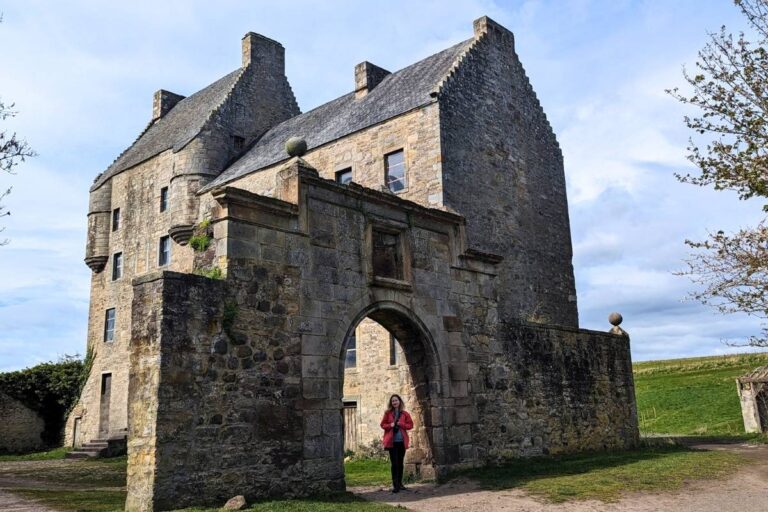

Thank you for this thorough and informative review of the sleeper train. Great tips and advice, which I’m taking on board for our trip next week!
Thank you! Have a wonderful time!
Hi! What a helpful review! At the time of commenting London to Glasgow is £50 each way (Nov 2023) booked in advance.
The pics are especially helpful, so thanks for those too 🙂
Hi Sanjay, thanks for your comment. £50 you say? That sounds like a bargain! May have to check it out 🙂
Thank you, really appreciate this, as it’s my first time taking the sleeper Glasgow to London next weekend. Your review really helped.
Hi Anabrese, thank you! I’m glad it helped. Enjoy your trip!
This is a great detailed, concise, informative review, thanks for putting it together.
Thank you! That means a lot.